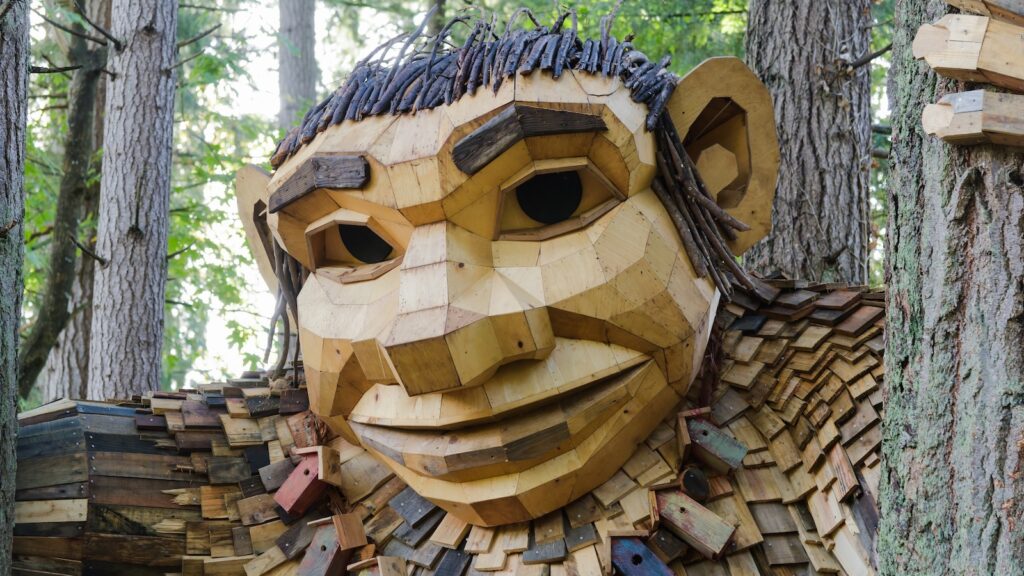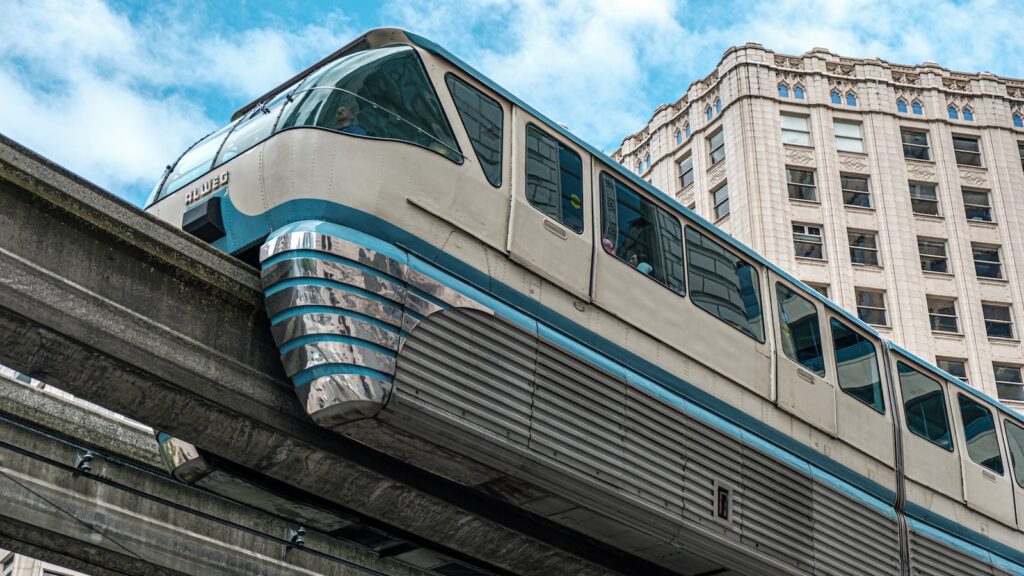While today’s Seattle is known as the tech hub of the Pacific Northwest, the older days of Seattle featured a quirkier city that brought about famous artists, bands, and sights that are uniquely Seattle. Thanks to the work of many dedicated volunteers, many of these sights still stand today as a reminder of the city’s past and how it shaped what it is today.
On top of that, many new displays have popped up that also add to the charm of the Emerald City.
So pack a lunch and hit the ferry, monorail, or bike as we take a tour around this beautiful city to uncover some of its quirkiest sights.
Northwest Trolls (Issaquah, Vashon Island, West Seattle, & Bainbridge)

For many hikers, it would be a dream (or a nightmare!) to stumble upon a giant troll while walking through the woods. For residents of Seattle and the surrounding suburbs, this dream is now a reality thanks to the works of Danish artist Thomas Dambo.
These larger-than-life trolls are built out of recycled materials and placed in their presumably natural settings. You can find them in Issaquah, Vashon Island, West Seattle, & Bainbridge Island and more are on the way across the country!
Post Alley

Located under the famous Pike Place Market, Post Alley has become a quirky must-see attraction for a very unique reason. Back in the 90s, concert-goers waiting in line to see a show at the Market Theater started sticking their used chewing gum along the brick-lined walls of the alley.
Slowly, the collection of gum grew, and its colorful and slightly repugnant look started to draw in tourists by the thousands. At one point, the bubble gum wall grew to several inches thick in places. It has since been scrubbed clean, but it didn’t take long for a new bubble gum wall to be established.
Kurt Cobain Bench

Seattle was known for its grunge scene in the 1990s, and the city birthed bands such as Soundgarden, Alice in Chains, and, most famously, Nirvana. After Nirvana frontman Kurt Cobain’s passing in 1994, fans flocked to the area to pay their respects and remember his impact on the music scene.
One such place that is still frequently visited is Viretta Park, which was directly next door to Cobain’s former home. It is believed that he used to come to the park and sit on one of its two benches to write music or enjoy the silence of nature.
While the original park benches have been replaced they still serve as a memorial with fans writing lyrics, leaving flowers, or just visiting to get a glimpse of what the Nirvana frontman’s life was like.
Center of the Universe Sign

The eclectic Fremont neighborhood just north of downtown Seattle has long been the center of quirkiness in the Seattle area. Numerous art displays are located throughout the neighborhood’s commercial core, and one such example is the Center of the Universe Sign.
Locals have posited since the 1970s that Fremont is the center of the universe because why not? But it wasn’t until the 1990s that they decided to fully recognize this recognition with a sign that directs visitors to places both near and far.
Lenin Statue

One of the locations noted on the Center of the Universe sign is the nearby Lenin statue. This statue of former Russian communist revolutionary Vladimir Lenin once stood in the Czechoslovak Socialist Republic before a series of events ultimately landed it in Fremont.
The statue is a frequent subject of controversy and discussion and has actually been for sale, and still is since it was first displayed in 1995.
Fremont Troll

The last stop on the Fremont tour is perhaps the city’s most famous quirky landmark: the Fremont Troll. This 18-foot-tall troll lives under the Aurora Bridge, where it has been delighting visitors since its unveiling over 30 years ago.
In its grasp is a real-life Volkswagen Bug, which you can assume was swiped off the bridge as it attempted to pass by the troll’s lair.
Seattle Monorail

There was a time when the monorail was seen as the future of public transportation, and in Seattle, you can still see and ride these trains of the future. The monorail makes frequent trips between the Seattle Center (home to the Space Needle, Kraken, Museum of Pop, etc.) and Westlake Center, which is located less than a mile away.
While it isn’t the most practical means of transport in the city, it is still enough of a tourist attraction that it has managed to remain open and in service since 1962.
Gasworks Park

Coal gasification plants used to be a mainstay in cities across the country as a way to produce both heat and light for municipalities. Natural gas slowly replaced this technology, and today, the only remaining (although long since decommissioned) coal gasification plant still standing is located at Gasworks Park in Seattle.
When the park was previously an industrial site that was transformed over a period of nearly 20 years into what you see today. The remains of the plant are mostly off limits although the childrens play structure utilizes some old components of the building.
Lakeview Cemetary

While Seattle has been home to many famous residents over the years two of its most notable are buried here and attract thousands of visitors each year. Actor Bruce Lee, along with his son Brandon Lee, are both interred at this historic cemetary.
It is said that Kurt Cobain was to be buried here as well, but the cemetary refused due to the already high number of visitors they received.
Pinball Museum

The Seattle Pinball Museum is home to the largest public collection of pinball machines in the entire Pacific Northwest. Whether you’re looking to play a game from the 1960s or want to uncover a hidden gem you can probably find it at this centrally located spot.
Olympic Sculpture Park

This large outdoor public sculpture space is a great spot to escape the hustle and bustle of downtown and nearby Pike Place. The park is filled with modern sculptures that date back to the 1960s.
Don’t miss the Eye Benches, Eagle, and Bunyon’s Chess.
A Sound Garden

Not to be confused with Seattle rock band Soundgarden (we’ll get to them in a second), A Sound Garden is an outdoor public art installation on the NOAA campus overlooking Lake Washington. The work consists of a series of steel structures that produce soft-tone sounds when stirred by the breeze.
The art installation is now more famous as being the namesake for the band Soundgarden. When band frontman Chris Cornell passed away in 2017, the garden turned into a makeshift memorial.
Freeway Park

Freeway Park stands over I-5, which cuts through the center of downtown Seattle. This brutalist architecture-styled park was seen as a way to connect the adjoining neighborhoods to downtown Seattle when the interstate cut the city in half.
Its real claim to fame, though, is that it is regarded as the first park ever built on top of a freeway, and that distinction earned it a place on the National Register of Historic Places in 2019.
Seattle Underground

The Seattle Underground is a series of abandoned passageways that can now be toured by visitors looking for a glimpse into the city’s past. These passageways were once the ground-level streets that ran through the city, but after a massive fire and requirements that streets be regraded one to two stories higher, these areas fell into disuse.
Over time the abandoned spaces became hotbeds for illicit activity but sections have since been restored to be used for tours. On these tours you can see the original storefronts that used to line this old section of the city.
